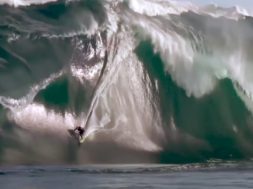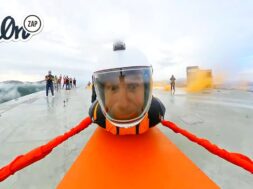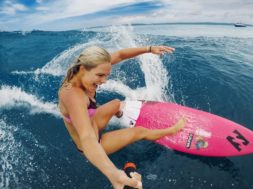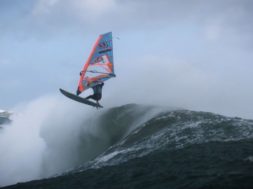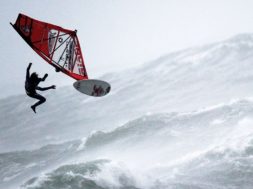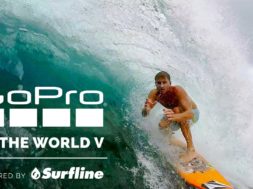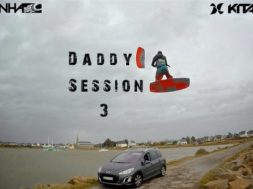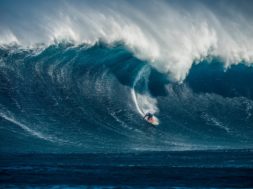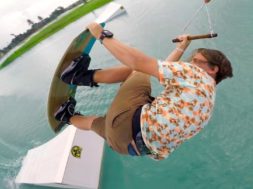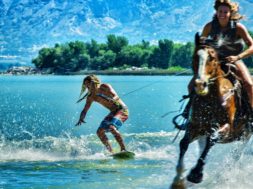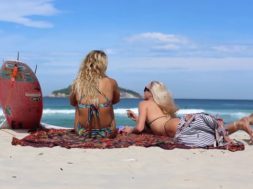Australia is home to the most deadliest surf breaks in the world. Waves like Sydney’s Ours / Cape Fear, Shipstern Bluff in Tasmania, Cyclops and The Right in western Australia are among the heaviest on the planet. And on top of that there are plenty of sharks…
Ours / Cape Fear
In New South Wales, Australia lies a break so carnal that even Pancho Sullivan was once said to want nothing to do with it. Located in the Kurnell National Park, Ours is a hollow, fast, powerful right-hander that breaks in front of a large cliff face. Even if you make the drop, which you probably won’t, then you’ve got to race through a barrel that wants to tear you limb from limb, and if you don’t make it you get pinned up against that cliff face we mentioned. This is also a favorite spot of the famed Bra Boys, so when they’re out, which is when it’s firing, you don’t want any part of it. If the waves don’t kill you, the locals might.
Shipstern Bluff
The bottom at Shipstern is a slab of granite that takes the brunt of huge swells traveling from deep water and expounding all their force onto this ledge. It also breaks right in front of a boulder-piled headland, adding even more risk to the already impossible drop. Add in the fact that you’ll need to be wearing a 4/3 wetsuit and booties almost year round here, and one can easily see why it’s only ridden by the most demented of chargers.
Cyclops
The depth change is extreme, and when giant swells roll in, they explode all their power onto the razor sharp coral. This causes Cyclops to take the shape of no other in the world, literally engulfing itself. Cyclops derived its name from the oval-like barrels that form once the chunky lip hits the reef. But not every wave is perfect here, and most times you’ll see a wave here that is so deranged in shape that you’ll probably shit your pants. Even if you can find the spot, good luck trying to make the drop, and then dealing with the shallow, deadly reef below.
The Right
the heaviest wave in West Australia. Notorious as one of the deadliest ‘monster’ waves of all, ‘The Right’ is a once-a-decade watery monolith which towers over anyone who dares to confront it by as much as a staggering 18 metres. That’s equivalent to over five storeys, or as high a perfectly decent sized swimming pool is long. Locals at Gracetown, Western Australia, are a fairly keen bunch when it comes to surfing, but even for them it’s a newsworthy event if someone manages to successfully ride of of these stupendous waves. Serious injury, or worse, is not unknown.
Big wave surfing is the ultimate celebration of extreme surfing. Challenging deadly waves in harsh weather and ocean conditions takes a very serious approach.
Big wave surfers are not interested in performance. Forget perfect cutbacks, stunning floaters or breathless aerial antics. The profile of a big wave rider is the result of several unparalleled personal characteristics.
Fear is always present in a 50-foot wave. Fear is the best way of managing the risk of paddling for a huge wave face, which doesn’t tell you what is going to happen and how it is going to break.
Monster waves tend to move quickly and force surfers to get away of the powerful whitewater. Big waves are lethal even for the most experienced extreme riders. The best big wave surf spots in the world have claimed several lives in the last decades.
Malik Joyeux, Sion Milosky, Moto Watanabe, Mark Foo, Donnie Solomon, Todd Chesser, Dickie Cross and Peter Davi have passed away in extreme surfing conditions. Wipeouts, severe coral reef injuries and drowning are the most common causes of death in big wave surfing.
The pioneers of big wave surfing started to eye impossible killer rides in the 1940’s. In the 1960’s, waves like Pipeline and Waimea increased the popularity of paddling into new wave heights. Going over the falls was the daily menu.
The 55 best big wave surfers of all time is an exclusive extreme surfing club. From Jaws to Mavericks, Puerto Escondido, Punta Lobos, Ghost Trees, Belharra, Shipstern Bluff and Todos Santos, Nazare. these riders have set up a new scale in the definition of giant waves. They are:
Al Mennie, Andy Irons, Anthony Tashnick, Ben Wilkinson, Bob Pike, Brock Little, Buzzy Trent, Carlos Burle, Chris Bertish, Danilo Couto, Darrick Doerner, Darryl Virostko, Dave Kalama, Dave Wassel, Eddie Aikau, Frank Solomon, Gabriel Villaran, Garrett McNamara, George Downing, Brad Gerlach, Gerry Lopez, Grant Twiggy, Baker Grant Washburn, Greg Long, Greg Noll, Ian Walsh, Jamie Sterling, Jay Moriarty, Jeff Clark, Jeff Rowley, Jose Angel, João de Macedo, Kai Barger, Keala Kennely, Ken Bradshaw, Ken Colllins, Koby Abberton, Kohl Christensen, Laird Hamilton, Laurie Towner, Mark Foo, Mark Healey, Mark Mathews, Mark Visser , Maya Gabeira, Mike Parsons, Nathan Fletcher, Pat Curren, Peter Mel, Ramon Navarro, Richie Fitzgerald, Ross Clarke-Jones, Shane Dorian, Sion Milosky, Zach Wormhoudt
36
